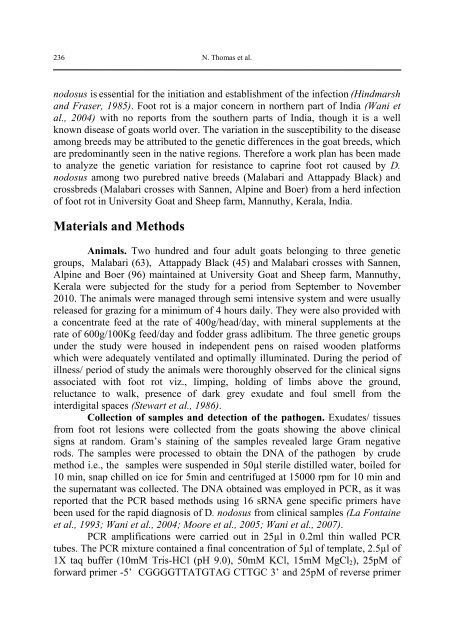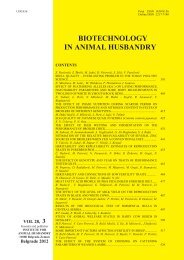Biotechnology in Animal Husbandry - Institut za Stočarstvo
Biotechnology in Animal Husbandry - Institut za Stočarstvo
Biotechnology in Animal Husbandry - Institut za Stočarstvo
Create successful ePaper yourself
Turn your PDF publications into a flip-book with our unique Google optimized e-Paper software.
236<br />
N. Thomas et al.<br />
nodosus is essential for the <strong>in</strong>itiation and establishment of the <strong>in</strong>fection (H<strong>in</strong>dmarsh<br />
and Fraser, 1985). Foot rot is a major concern <strong>in</strong> northern part of India (Wani et<br />
al., 2004) with no reports from the southern parts of India, though it is a well<br />
known disease of goats world over. The variation <strong>in</strong> the susceptibility to the disease<br />
among breeds may be attributed to the genetic differences <strong>in</strong> the goat breeds, which<br />
are predom<strong>in</strong>antly seen <strong>in</strong> the native regions. Therefore a work plan has been made<br />
to analyze the genetic variation for resistance to capr<strong>in</strong>e foot rot caused by D.<br />
nodosus among two purebred native breeds (Malabari and Attappady Black) and<br />
crossbreds (Malabari crosses with Sannen, Alp<strong>in</strong>e and Boer) from a herd <strong>in</strong>fection<br />
of foot rot <strong>in</strong> University Goat and Sheep farm, Mannuthy, Kerala, India.<br />
Materials and Methods<br />
<strong>Animal</strong>s. Two hundred and four adult goats belong<strong>in</strong>g to three genetic<br />
groups, Malabari (63), Attappady Black (45) and Malabari crosses with Sannen,<br />
Alp<strong>in</strong>e and Boer (96) ma<strong>in</strong>ta<strong>in</strong>ed at University Goat and Sheep farm, Mannuthy,<br />
Kerala were subjected for the study for a period from September to November<br />
2010. The animals were managed through semi <strong>in</strong>tensive system and were usually<br />
released for graz<strong>in</strong>g for a m<strong>in</strong>imum of 4 hours daily. They were also provided with<br />
a concentrate feed at the rate of 400g/head/day, with m<strong>in</strong>eral supplements at the<br />
rate of 600g/100Kg feed/day and fodder grass adlibitum. The three genetic groups<br />
under the study were housed <strong>in</strong> <strong>in</strong>dependent pens on raised wooden platforms<br />
which were adequately ventilated and optimally illum<strong>in</strong>ated. Dur<strong>in</strong>g the period of<br />
illness/ period of study the animals were thoroughly observed for the cl<strong>in</strong>ical signs<br />
associated with foot rot viz., limp<strong>in</strong>g, hold<strong>in</strong>g of limbs above the ground,<br />
reluctance to walk, presence of dark grey exudate and foul smell from the<br />
<strong>in</strong>terdigital spaces (Stewart et al., 1986).<br />
Collection of samples and detection of the pathogen. Exudates/ tissues<br />
from foot rot lesions were collected from the goats show<strong>in</strong>g the above cl<strong>in</strong>ical<br />
signs at random. Gram’s sta<strong>in</strong><strong>in</strong>g of the samples revealed large Gram negative<br />
rods. The samples were processed to obta<strong>in</strong> the DNA of the pathogen by crude<br />
method i.e., the samples were suspended <strong>in</strong> 50µl sterile distilled water, boiled for<br />
10 m<strong>in</strong>, snap chilled on ice for 5m<strong>in</strong> and centrifuged at 15000 rpm for 10 m<strong>in</strong> and<br />
the supernatant was collected. The DNA obta<strong>in</strong>ed was employed <strong>in</strong> PCR, as it was<br />
reported that the PCR based methods us<strong>in</strong>g 16 sRNA gene specific primers have<br />
been used for the rapid diagnosis of D. nodosus from cl<strong>in</strong>ical samples (La Fonta<strong>in</strong>e<br />
et al., 1993; Wani et al., 2004; Moore et al., 2005; Wani et al., 2007).<br />
PCR amplifications were carried out <strong>in</strong> 25µl <strong>in</strong> 0.2ml th<strong>in</strong> walled PCR<br />
tubes. The PCR mixture conta<strong>in</strong>ed a f<strong>in</strong>al concentration of 5µl of template, 2.5µl of<br />
1X taq buffer (10mM Tris-HCl (pH 9.0), 50mM KCl, 15mM MgCl2), 25pM of<br />
forward primer -5’ CGGGGTTATGTAG CTTGC 3’ and 25pM of reverse primer




